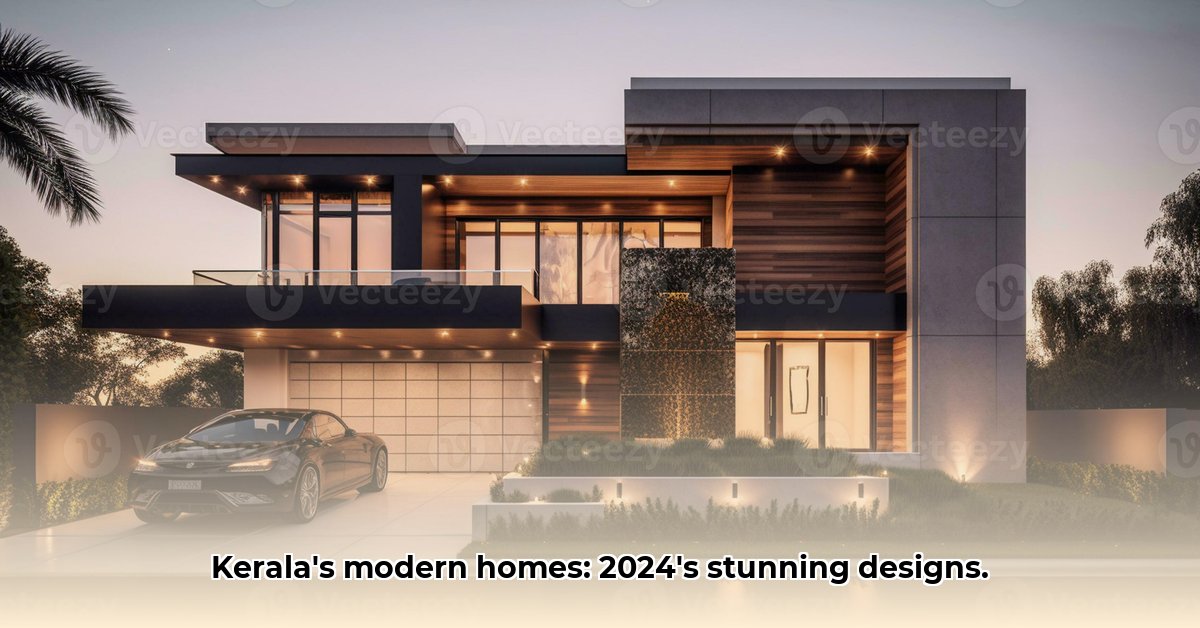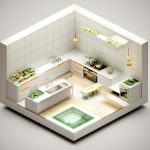Imagine a place where lush green hills meet the Arabian Sea, where ancient traditions whisper secrets to modern designs. That’s Kerala, and its homes tell a fascinating story. This isn’t just about houses; it’s about a journey – from the classic, centuries-old designs to the sleek, sustainable homes of today. For more stunning examples, check out these Kerala home designs. We’ll explore the heart of traditional Kerala architecture, from the iconic Nalukettu and Ettukettu houses to the clever use of courtyards and natural materials. Then, we’ll see how modern architects are taking these ideas and blending them with cutting-edge technology and eco-friendly practices. Get ready to see stunning examples of modern Kerala homes – from cozy apartments to sprawling villas – all showcasing a unique blend of old and new. We’ll even talk about the challenges and exciting future trends shaping the way homes are built in this amazing part of the world. So, let’s dive into the beautiful world of Kerala house design!
Modern House Designs in Kerala: 2024 Trends & Sustainability
Kerala’s homes—they’re something special. For centuries, traditional designs have blended seamlessly with the landscape, creating homes as unique as the state itself. From the elegant curves of a Nalukettu, a classic courtyard house, to the sprawling grandeur of an Ettukettu with its multiple wings, these aren’t just buildings; they’re living testaments to Kerala’s rich history and culture. But what happens when that rich heritage meets the demands of modern living? That’s the exciting story we’re about to explore.
Traditional Kerala Homes: A Legacy of Harmony and Vastu Shastra
Imagine stepping into a traditional Kerala home. The air is cool, thanks to the clever design of the Nadumuttom, the central courtyard that acts like a natural air conditioner. The sloping roofs, a masterpiece of engineering, effortlessly shed the monsoon rains. Natural materials—rich, warm wood, sturdy laterite stone, and earthy clay—dominate, creating spaces that feel connected to the land. These homes weren’t just built; they were carefully crafted, following the principles of Vastu Shastra, an ancient Indian architectural system focusing on harmony with nature and positive energy flow. It’s about creating a home that’s not just beautiful but also balanced and nurturing. Consider the intricate woodwork, often depicting scenes from epics, showcasing the skill of local artisans.
- Traditional designs emphasize natural ventilation and lighting.
- Homes are crafted with locally sourced materials like teak wood and clay tiles.
- Vastu Shastra principles ensure harmony with nature, influencing everything from room placement to the direction a house faces.
Modern Kerala Homes: Tradition Meets Innovation
Now, fast forward to today. Modern Kerala home designs are a fascinating blend of old and new. Architects are skillfully incorporating those old, beautiful elements into sleek, contemporary spaces. You’ll find minimalist homes with those signature sloping roofs, but now they’re paired with expansive glass windows that flood the interiors with natural light. Open floor plans create a sense of spaciousness, while retaining the connection to the outdoors through strategically placed verandas and balconies. Modern kitchens seamlessly integrate with living areas, and bedrooms become tranquil retreats with attached bathrooms and dressing areas.
Other homes exhibit a charming colonial-fusion style, blending traditional features with influences from European architecture—a delightful mix of cultures and styles, often featuring high ceilings and ornate details. The result? Houses that are both stunningly beautiful and incredibly functional, showcasing the best of both worlds.
Embracing Sustainability: Building Green in God’s Own Country
Kerala’s climate—hot and humid with a heavy monsoon season—naturally lends itself to sustainable building practices. Modern Kerala homes are increasingly eco-friendly, and sustainability is not just a trend, but a necessity. Rainwater harvesting systems are becoming standard, reducing dependence on municipal water supplies, with some homes even incorporating filtration systems to provide potable water. Solar panels are popping up everywhere, offering a clean energy source. Architects are prioritizing locally sourced, sustainable materials like bamboo, recycled timber, and even locally sourced stone, minimizing the environmental impact of construction. Smart home technology further boosts energy efficiency, controlling lighting, temperature, and appliances.
The integration of green roofs and vertical gardens not only enhances the aesthetic appeal but also helps in temperature regulation and improves air quality. It’s about creating a home that respects the environment as much as it respects its inhabitants.
Showcasing Stunning Kerala Homes: Real-World Examples
Let’s look at some specific examples of this exciting architectural fusion. These aren’t just theoretical designs—these are real homes, each reflecting unique styles and personal preferences.
| Project | Style | Approximate Square Footage | Notable Features |
|---|---|---|---|
| Lakeside Villa | Modern Minimalist | 3,800 sq ft | Infinity pool overlooking the lake, open-plan living, solar panels, rainwater harvesting |
| Hillside Retreat | Contemporary | 2,200 sq ft | Green roof, vertical garden, passive cooling design, use of locally sourced stone |
| Coastal Bungalow | Coastal Colonial Fusion | 3,000 sq ft | Expansive verandas, intricate woodwork, state-of-the-art kitchen, panoramic ocean views |
| Urban Family Home | Updated Nalukettu | 3,200 sq ft | Traditional courtyard, sloped roof, updated energy-efficient windows and appliances |
These projects beautifully illustrate the diverse interpretations of modern Kerala architecture, showcasing the incredible blend of tradition and innovation.
The Challenges Ahead: Preserving Heritage
One significant hurdle is preserving traditional craftsmanship alongside modern construction techniques. Finding skilled artisans to create intricate wood carvings or other specialized elements is becoming increasingly challenging. The rising cost of land and materials can also be a barrier to building eco-friendly homes. However, a growing awareness of the importance of sustainable living is driving demand for green building practices, and government initiatives are providing incentives for eco-friendly construction.
Future Trends: A Glimpse into Tomorrow’s Kerala Homes
Likely, future Kerala homes will integrate even more advanced smart home technology, further boosting sustainability and efficiency. Expect space-optimized designs that cater to smaller land plots without sacrificing the beauty and functionality that defines Kerala homes. We could also see a resurgence of traditional techniques, revived through technological advancements. The use of pre-fabricated elements could speed up construction and reduce costs, while 3D printing technology could be used to create intricate architectural details. The possibilities for exciting, sustainable, and beautiful homes in Kerala are truly endless.
How to Incorporate Vastu Shastra in Modern Kerala Home Designs
Key Takeaways:
- Vastu Shastra principles offer valuable insights for modern Kerala home design.
- Harmonizing traditional wisdom with contemporary aesthetics is key.
- Accurate directional measurements are crucial.
- Strategic room placement impacts energy flow.
- Sustainability and eco-friendly practices complement Vastu principles.
Traditional Kerala Architecture and Vastu
Kerala’s architectural heritage, exemplified by the Nalukettu and Ettukettu homes, demonstrates the harmonious integration of building design and Vastu Shastra. These traditional homes, with their sloped roofs, central courtyards, and natural materials, were designed to maximize natural light, ventilation, and positive energy flow. Vastu seeks to align a building with the natural rhythms of the environment, creating a space that promotes well-being.
Modern Interpretations: Blending Tradition and Innovation
Today’s Kerala homes often embrace open-plan layouts and modern materials. But how can we incorporate Vastu principles without sacrificing contemporary aesthetics? The answer lies in mindful adaptation. For instance, while a traditional Nalukettu might feature a distinct puja room in the northeast corner, a modern home might seamlessly integrate a dedicated prayer space within an open-plan living area, respecting the northeast’s auspicious energy. The use of light colors, natural materials, and specific geometric patterns can also enhance the positive energy flow throughout the home.
The essence of Vastu isn’t about strict adherence to rigid rules, but about understanding and leveraging the principles of balance and harmony. Large windows and strategic placement of openings maximize sunlight and create a bright, airy atmosphere. And incorporating natural materials, like wood and laterite stone, echoes the sustainable spirit of traditional Kerala architecture while adding a touch of timeless elegance.
Sustainability and Eco-Conscious Design
Kerala’s tropical climate demands sustainable building practices, and embracing eco-conscious design naturally aligns with Vastu principles. Energy efficiency becomes a crucial aspect. Vastu’s emphasis on natural ventilation and sunlight minimizes the need for artificial lighting and cooling. The use of locally sourced, sustainable materials further reduces the home’s carbon footprint.
Case Study: A Modern Kerala Home
Imagine a modern two-story home, approximately 2500 square feet, set amidst lush greenery. Its design thoughtfully incorporates Vastu principles: the master bedroom occupies the southwest corner, enjoying the calm evening breeze; the kitchen resides in the southeast; and the living area, bathed in natural light, opens to a courtyard, creating a tranquil heart of the home. The integration of solar panels and a rainwater harvesting system further enhances the home’s eco-friendliness.
Challenges and Future Trends
One of the main challenges is to balance the need for modern amenities with the principles of Vastu. However by understanding how to integrate eco-friendly features and construction, future homes can find design harmony and balance. With the preservation of traditional building techniques modern homes can look toward sustainability and traditional elements coming together.
- White On White Kitchen Backsplash: Is It Timeless? - November 20, 2025
- Backsplash Colors for White Cabinets: Find Your Perfect Match - November 19, 2025
- Backsplash Ideas for White Cabinets: Find Your Perfect Style - November 18, 2025










